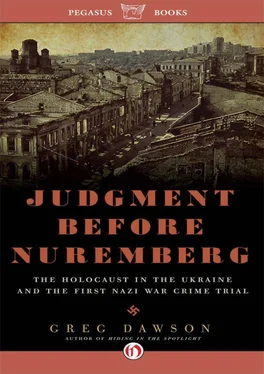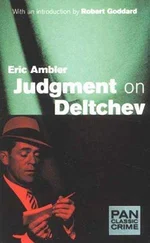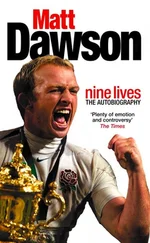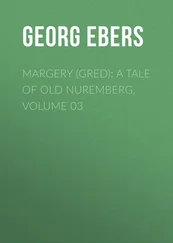Another early casualty of the Cold War was justice after Nuremberg. Eagerly catering to West Germany, their new ally against the Soviets, the U.S. and Britain began granting clemency to Nazis the way Shriners toss candy to kids on a parade route. The High Commissioner of Germany, American John McCloy, paroled sixty convicted German war criminals at the end of 1949. The U.S. and Britain turned a blind eye on West Germany’s hear-no-evil-see-no-evil pursuit of suspected war criminals which netted a pathetic 13 death sentences and 163 life prison terms out of 103,823 investigations from the end of the war until 1992.
“In many respects the punishments meted out against German war criminals by Allied and German courts alike bore no relation to the horrible crimes that had been perpetrated,” wrote Kochavi. He thought it no coincidence that the U.S. and Britain did not experience firsthand the horrors of Nazi occupation. “The physical distance of government officials from the crime scenes may have led to a certain callousness. Those who dealt with the issue proved simply insensitive to the suffering that people under German domination endured.” [13] Arieh Kochavi, Prelude to Nuremberg: Allied War Crimes Policy and the Question of Punishment (University of North Carolina Press, 1998), 231, 247.
In the meantime, the Soviets had to endure criticism from the West that the Kharkov trial and others which followed across the U.S.S.R. were carbon copies of the tainted “show trials” of the 1930s, which railroaded Soviet citizens “guilty” of nothing more than fabricated disloyalty to Stalin. That impression was compounded by Stalin’s insistence at Yalta on the forced repatriation of Russian soldiers and civilians whom he bizarrely considered traitors for being stuck in German prisons or displaced persons camps at the end of the war. Many of those dragged back to the Motherland were executed or sent to gulags, the likely fate of my mother, who was in a DP camp near Munich and set to return voluntarily , but would not go without her sister Frina, who adamantly—presciently—refused. Between Stalin’s outrages and the showcasing of Soviet dirty laundry, the mountains of crucial evidence gathered by Soviets against the Nazis and presented at Nuremberg never received the attention or credit it deserved. My goal is to ensure that that does not happen to the trial at which the evidence was first used to convict Nazis of their crimes.
“The importance of domestic war crimes trials such as the Kharkov trial lies not only in their bringing of Nazi war criminals to justice, but also their effect, as put by Professor Ginsburgs, of pointing the way toward the grand finale at Nuremberg,” Bazyler wrote. [14] Bazyler, “The Role of the Soviet Union in the International Military Tribunal,” Titel des Artikels , 4.
Ginsburgs concedes that the Kharkov trial “was a methodically staged mise en scène ,” but adds, “We have no indication that the German defendants had either been rehearsed or coerced. Nor has any solid evidence ever been adduced that the accused were not in fact guilty of the crimes to which they so willingly confessed.”
The road to Nuremberg from my mother’s back yard, from my grandparents’ and great-grandparents’ grave at Drobitsky Yar, from the courtroom in Kharkov was paved with vengeance, yes, but also with something resembling true justice. John McCloy should have done half as well.
On Wednesday morning, December 15, 1943, hundreds of residents of liberated Kharkov filed into the Opera House on Rymarska Street, which runs parallel to Sumskaya Street, where the SS and German military command were headquartered during occupation of the city. A grand, neo-classical structure, the Opera House had miraculously emerged unscathed from two years of brutal Nazi rule, punctuated by four battles for the city, which left much of Kharkov in ruins. The ornate hall had been transformed into a courtroom where three German officers and a Russian collaborator were cast as antagonists in a drama whose denouement was as predictable and eagerly awaited as the grand operas presented on the stage.
Each person entering the Opera House held a red ticket good for that session only. Every day the seats would be filled by a different group of lucky citizens holding the toughest ticket in town—even more coveted than a ticket to a Deanna Durbin picture showing in one of the reopened movie theaters in Kharkov, which was slowly coming back to life after the suspended animation of the Nazi occupation. The tickets “were distributed to factory workers and office employees through their trade union organizations, so that the audience kept rotating,” Edmund Stevens wrote in the Christian Science Monitor.
The Soviets prepared for and gained international coverage of the trial—and not just from correspondents for major newspapers such as the New York Times and Christian Science Monitor. Stories from Reuters, Associated Press, United Press, and other agencies ran on the front pages of small-town newspapers across America. “First War Guilt Trial Held On Kharkov Deaths” was the headline in The Oelwein (Iowa) Daily Register. “Nazi Soldiers Describe Brutal Execution Methods During Trial at Kharkov,” said The Rhinelander (Wisconsin) Daily News. Page 1 of The Charleston (West Virginia) Gazette: “Traitor Bares Nazi Horrors.”
Foreign reporters were admitted only to the final day of the four-day trial (and were free to witness the subsequent public executions). Their earlier stories were based on published accounts by Soviet writers—the crème de la crème of Soviet journalism—whose reports were funneled through Moscow. This led to confusion at some U.S. newspapers such as The Port Arthur (Texas) News, which ran a bold-type headline: “Murder Of Children Described At Moscow Trials.”
Klieg lights were set up in the makeshift courtroom to film the trial for a feature-length documentary. In format and presentation it certainly was an elaborate mise en scène like the infamous show trials of the 1930s. And what better place for a staged production than an opera hall? The Soviets were hungry for payback and eager for the world to learn about Nazi crimes against the Motherland. A good “show” would further that goal. But there was a show, a masquerade, within the show—like two matryoshka dolls, the larger one missing a crucial detail, a single paint stroke. Hidden inside was the true face, the momentous truth Soviet authorities were denying: this was the first trial of Germans for crimes that would become known as the Holocaust. The murdered Jews of Kharkov were among the first of the six million to die. Yet, they were invisible at the Kharkov trial.
“Both the Krasnodar and Kharkov trials omitted mention of the Nazi murder of Jews,” wrote Alexander Prusin. “Although by 1943 the Holocaust had become common knowledge and the ESC (Extraordinary State Commission) possessed massive evidence of the scope of the genocide, the tribunals referred to the executions of Jews as ‘massacres of Soviet citizens.’ The indictment in Kharkov referred to the ghettoization of Jews as ‘forceful resettlement of Soviet citizens’ to the outskirts of the city.” [1] Alexander Prusin, “Fascist Criminals to the Gallows!: The Holocaust and Soviet War Crimes Trials, December 1945–February 1946,” Holocaust and Genocide Studies (Spring 2003), 6.
The Soviet government knew for certain in January 1942 “that the Jews were being annihilated, and up to the end of the war, neither Stalin nor his counterparts in Soviet leadership made any public reference to the matter,” Arad wrote.
Читать дальше












